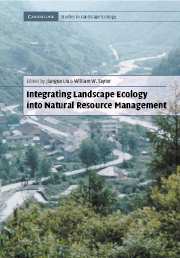Book contents
- Frontmatter
- Contents
- List of contributors
- Foreword
- Preface
- Acknowledgments
- PART I Introduction and concepts
- PART II Landscape structure and multi-scale management
- 2 Integrating landscape structure and scale into natural resource management
- 3 Focal patch landscape studies for wildlife management: Optimizing sampling effort across scales
- 4 Managing for small-patch patterns in human-dominated landscapes: Cultural factors and Corn Belt agriculture
- 5 A landscape approach to managing the biota of streams
- 6 Linking ecological and social scales for natural resource management
- PART III Landscape function and cross-boundary management
- PART IV Landscape change and adaptive management
- PART V Landscape integrity and integrated management
- PART VI Syntheses and perspectives
- Index
- Plate Section
6 - Linking ecological and social scales for natural resource management
Published online by Cambridge University Press: 14 January 2010
- Frontmatter
- Contents
- List of contributors
- Foreword
- Preface
- Acknowledgments
- PART I Introduction and concepts
- PART II Landscape structure and multi-scale management
- 2 Integrating landscape structure and scale into natural resource management
- 3 Focal patch landscape studies for wildlife management: Optimizing sampling effort across scales
- 4 Managing for small-patch patterns in human-dominated landscapes: Cultural factors and Corn Belt agriculture
- 5 A landscape approach to managing the biota of streams
- 6 Linking ecological and social scales for natural resource management
- PART III Landscape function and cross-boundary management
- PART IV Landscape change and adaptive management
- PART V Landscape integrity and integrated management
- PART VI Syntheses and perspectives
- Index
- Plate Section
Summary
Introduction
Natural resource management has moved from a single disciplinary and one resource management approach to an interdisciplinary and ecosystem-based approach. Many conceptual models are being developed to understand and implement ecosystem management and forest certification initiatives that require an integration of data from both the social and natural systems (Vogt et al., 1997, 1999a,b). These changed approaches to natural resource management arose from a perception that variables critical in controlling the health and functioning of an ecosystem could only be determined by integrating information from both the social and the natural sciences (Vogt et al., 1997). However, it has been difficult to take many of the theoretical discussions and the frameworks or conceptual models that they have produced and to operationalize or put them into practice on the ground.
Despite these discussions and the recognition of their importance, social and natural science data have been ineffectively incorporated into the management and trade-off assessments of natural resources (Berry and Vogt, 1999).We hypothesize that some of this has occurred because of the distinct spatial scales being used by different disciplines which have not allowed for integration of information to occur at a causal level. The complexity and uncertainty of data needed to understand ecosystems by both social and natural scientists have also made it difficult for managers to recognize when the wrong indicators are being monitored or whether a system could degrade due to management (Larson et al., 1999; Vogt et al., 1999c). The need to link data causally from both disciplines as part of ecosystem management has given greater impetus to develop practical tools that would allow this integration to be accomplished.
- Type
- Chapter
- Information
- Integrating Landscape Ecology into Natural Resource Management , pp. 143 - 176Publisher: Cambridge University PressPrint publication year: 2002
- 15
- Cited by

